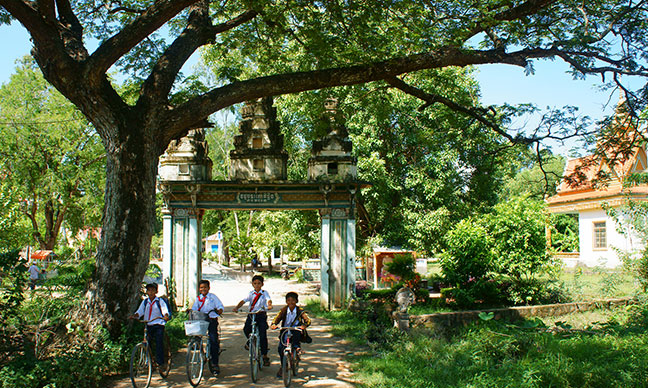The climate conditions in Texas are balanced enough to let you enjoy Texas shade trees throughout all seasons. In addition, if you are one of many people who are blessed with a big lawn space, you can add memorable aesthetics to your home and provide shade where you can spend hot summer months. The type of tree you decide to plant will be determined by the soil, maintenance, and location of your garden.
Related Post: Texas Soil
Keep reading to find out more about the best shade trees for Texas and which one would fit your needs the most!
Related Posts: Best Time To Plant Trees In Texas & Evergreen Trees Texas
Texas Shade Trees – Popular Varieties
Pest issues, adaptability to soils, and limitations of temperature are some of the most important factors when it comes to determining which shade tree is the best in Texas. Check out the list below to find out which varieties are the most popular in the state!
1. Live Oak
Live oak is probably one of the most-revered Texas shade trees, according to tree service Texas companies, professional arborists, and homeowners. The tree is native from the Red River to the Gulf Coast. It can grow up to 400 feet in height and can spread its branches more than 75 feet wide. Small city lots are not suitable for live oaks, so make sure you think about the space you can provide for this tree.
In some areas, live oak is susceptible to oak wilt, so consult with your local arborist whether you need to check regularly for symptoms. Some specimens in Texas are older than 1,000 years and are still in decent health.
Related Post: Oak Trees In Texas
2. Shumard Red Oak
Shumard oak is native shade tree from Dallas up to the Hill Country. It can reach up to 50 feet in height and width when fully matures. This tree offers deep green colors during summer, so they can be a great addition to your garden. Usually, vibrant red fall color is common, but the color may vary in certain conditions. Consult with your local nursery when buying Shumard oak since pin oaks and some other specimens are labeled as shumards.
3. Chinquapin Oak
Chinquapin oak is native to East and North-Central Texas. It can reach up to 50 feet in width and in height when it fully matures. Fall colors are not very impressive, but deep green summer color is what this oak is known for. The bark is usually gray and attractive, making this tree even more desirable if you’re working on a beautiful landscape. However, this tree is not as common as other trees on this list, but it is definitely one of the best shade trees for Texas.
4. Bur Oak
Bur oaks can reach up to 60 feet in height when they fully mature and are one of the most popular shade trees for Austin. They are characterized by the huge acorns and leaves, and coarse-textured bark. It is native from Central Texas all the way up to Canada, making it one of the more popular varieties. Bur oaks are known for really fast growth and high-quality wood. This tree doesn’t have very interesting fall color, but its fast growth, soil tolerance, and beautiful looks make it one of the best shade trees for Texas.
5. Cedar Elm
Cedar elm is the shining exception among elms. Usually, tree experts don’t consider elms to be very good trees, but cedar elm offers everything you might wish for. They are adapted all over the state, but they are native to North-Central Texas. The tree can grow up to 50 feet tall and can spread up to 40 feet wide when it fully matures. Small, deep green leaves are usual for this tree, and they offer a yellow fall color. Keep in mind that cedar elms are susceptible to mistletoe.
Related Post: North Texas Trees
6. Pecan
Pecan is the state tree of Texas and it is known for producing high-quality nuts that generate a lot of income for the state. It grows up to 60 feet in height and can spread its branches up to 50 feet in width. The trees may vary greatly in appearance and form, but also in the quality of the nuts they produce. Buy a grafted tree for your area if you’re planning to plant a new one. Various insects and diseases in Forth Worth and other pecan populated cities are common among these trees, but they are usually interested in the nuts and not the tree itself. Consult with your local arborist to find out what can you use to spray the tree in your area.
Related Posts: Types Of Pecans In Texas & Pecan Tree Diseases
7. Chinese Pistachio
Chinese pistachio is the only non-native tree on this list. However, it offers almost everything other trees do. It grows up to 50 feet in height and width and gives high-quality products. The summer foliage is deep green and it also stays that way each fall when it turns red. There are several safety steps you need to take to protect it from damage, so it is recommended to consult with your local arborist when planting.
FAQ
Q: What is a fast growing shade tree for Texas?
A: Fast-growing shade trees in Texas are those trees that develop really fast and provide enough shade on a location. They are usually very tall, wide, and have interesting foliage. In addition, these trees can survive for a very long time, even though they usually grow really fast.
Q: What are the best trees for shade?
A: The best trees for shade in Texas are usually different varieties of oaks. These trees offer almost everything you want – enough shade, low maintenance, and fast growth. Also, oaks are usually not susceptible to fungus and diseases, but in some areas, they have problems with oak wilt.
Related Posts: Tree Diseases Texas & Tree Fungus Texas
Q: What is the best tree to plant in Texas?
A: The best tree to plant in Texas is probably live oak. This tree is one of the most popular varieties since it provides everything a homeowner needs. It will provide enough shade and it requires almost no maintenance. Live oak has beautiful foliage during summer and fall.
Related Post: Fall In Texas
Local Tree Experts Overview
Hopefully, this article can help you determine which one of the Texas shade trees is the best fit for you and your garden. These trees are usually really tall and wide, so make sure you provide enough space. Also, consult with your local arborist to learn how to properly maintain this type of tree!




